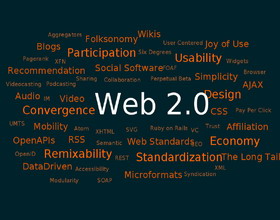 Notes from Lorcan Dempsey’s excellent talk on making more out of data resources.
Notes from Lorcan Dempsey’s excellent talk on making more out of data resources.
Characteristics of Web 2.0 are the flattening of applications and the ability to stitch these services together in new ways that were previously quite complicated or impossible to do. Rich interaction technologies (like AJAX) as illustrated through services like Google Maps, present new ways of interacting with web pages within the browser.
“Data is the new functionality.” Or the new “Intel Inside,” as Tim O’Reilly would say. It’s about making data work harder thorough collection, exploitation and mining. Large reservoirs of data lead to interesting experiences for the users (Amazon lists, Google page ranking, and any number of other examples could be used). And of course, participation. “Mobilizing the user” and capturing the “vitality” of the user make many of these new web services what they are today.
Light weight service composition
OCLC’s Audience Level rating- there’s “hints” and suggestions of what level materials may be at based on which libraries have it (ie school, academic, public library). A Greasemonkey script interacts with an item-level Amazon page to send the ISBN to OCLC’s webservice. This will in turn bring back a hint of who the audience might be for a given title.
AJAX
Livesearch – similar to Google Suggest (but different). It brings back results in a FRBR-inspired manner. This can be narrowed by Dewey attributes. Ranked by holdings worldwide (a library popularity indicator), as you begin to type, items are returned matching the characters typed.
The classified list matching your input is displayed on the sidebar, which provides another way for the user to explore similar items or items of interest within related topics. [I think these sorts of tools are extremely valuable and long overdue in the digital world. An interface such as this brings back the ability to browse and associate items in a way that was just never replicated in a rigid form based search field.]
Making data work harder
FictionFinder – Lorcan gave a preview of the soon to be launched service, FRBRized and made available through faceted browsing. This creates a much richer experience and again, allows users to much more easily find their way into the resources of libraries. Normally hidden fields such as “setting’ for fiction books are now available for people to easily use.
The new FictionFinder will be available a few weeks from now (although the old version is still up on the site).































